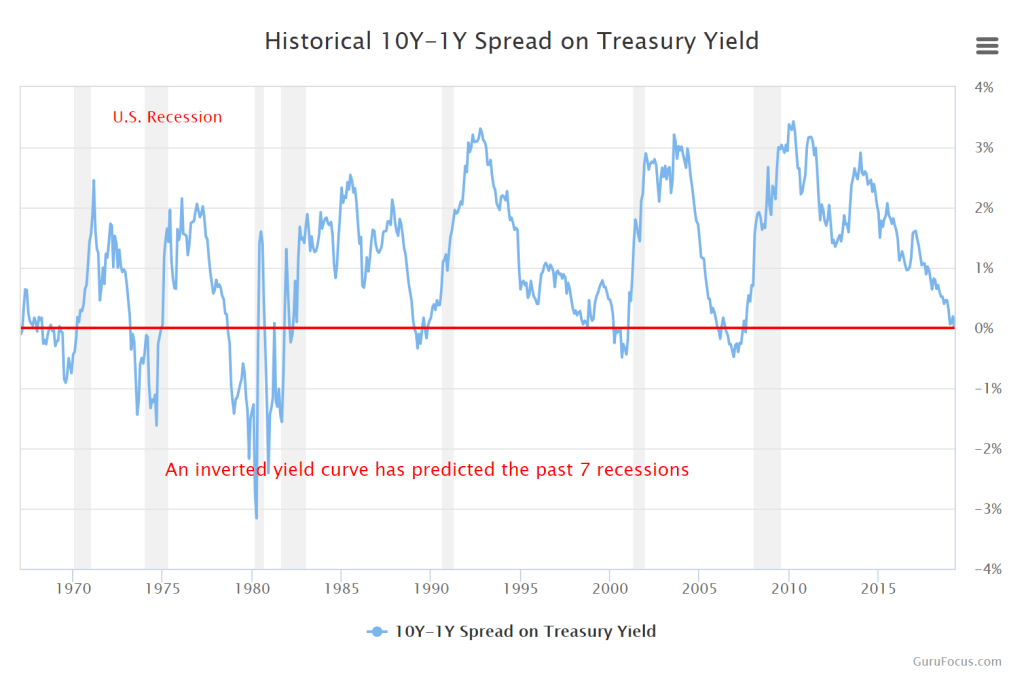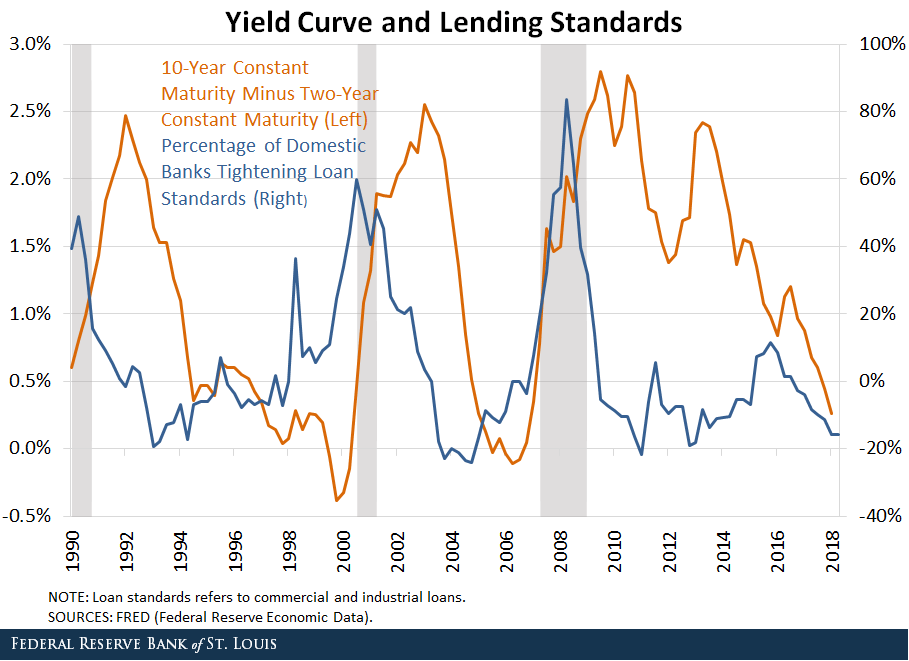Since the U.S. yield curve first inverted in December (I wrote about it the day it happened – read here) – I’ve seen mainstream financial media pundits shrug it off. They’ve highlighted that the U.S. economic data is still relatively solid. And that there’s no recession in sight.
I’ve read ‘respected’ analysts say things like:
“Who care if yields invert? It means nothing these days.”
“It’s an outdated tool that doesn’t belong in a post-Quantitative Easing (QE) world.”
And even though many pundits want to disregard this yield inversion – I urge you to ignore them. Let me explain. . .
For starters – why is the yield curve inverting to begin with?
Historically, the Fed raises short-term rates when they believe the economy is doing well – which means inflation and growth picking up – justifying higher rates of interest. (And vice versa when the economy is doing poorly).
And since December 2015 – the Fed’s been tightening via rate hikes (and Quantitative Tightening – QT) because they see the U.S. economy outperforming.
But bond investors aren’t so sure.
They don’t believe that the economy’s as strong as the Fed says it is. So they’re buying longer-term bonds – which pushes yields down – to lock in the higher yields today since they expect the Fed will begin cutting rates sooner than later (when they have to fight a deflationary recession).
Thus – instead of bond investors pricing in growth and inflation (a steeper yield curve), they’re instead pricing in deflation and a recession (an inverted yield curve).
So, what the inverted yield curve tells us is that the bond market’s expecting slower growth, deflation, and a recession.
And although many analysts and pundits want to disagree with bond investors and claim that the economy is looking good – the Fed themselves even admitted defeat.
It isn’t a coincidence that the Fed has effectively paused their tightening program since the yield curve first inverted in early December 2018.
That’s because they know if they continue hiking rates – pushing up shorter term yields – they will further invert the yield curve.
And that will actually tip the U.S. into a recession.
Here’s why I say that. . .
Note that the last seven straight recessions followed an inverted yield curve. . .
(This chart shows the difference between one-year yields and ten-year yields. When it dips below negative, that means the one-year yield is higher than the ten-year bond. Which signals deep inversion).

The recession won’t happen immediately – it will take a few months (maybe even a year) to manifest. But it will happen.
Why?
Because the yield-curve isn’t some useless signal that the pundits believe it is. It’s a crucial leading-indicator for bank lending. . .
As the yield curve flattens – and later inverts – it curtails commercial bank lending.
And without any new lending – there’s no way for households or firms to borrow and refinance and spend.
This greatly reduces economic growth.
Take a look at the chart below – highlighting the yield curve and bank lending standards.

(Note that this chart is slightly outdated – as of today the 2/10 yield curve has already inverted i.e. dipped below zero).
You can see that during the last three recessions – 1991, 2001, 2008 – bank lending (blue line) tightened dramatically shortly after or right before the yield curve inverted (yellow line).
Why does this happen?
Well – the Fed’s surveyed banks on their lending practices since the early 1990’s.
And when they recently asked how their lending practices would be impacted in response to a “moderate inversion of the yield curve” – it wasn’t what they wanted to hear. . .
Many of the surveyed banks indicated they would sharply tighten lending standards.
When asked why – they gave three main reasons:
First – an inverted yield curve could cause loans to generate less profits relative to the banks cost of funding. (Remember – banks ‘borrow short, lend long’ – thus inversion would put them deep in the red).
Second – an inverted yield curve would cause banks to shy away from making risky loans.
And Third – an inverted yield curve signals a “less favorable or more uncertain” economic outlook. (Because of the historical tendency for inversion to precede a recession – banks wouldn’t want to lend money if they expect slowing growth).
It’s clear from the chart above – and from the answers the banks gave – that the more yields invert, the more banks will tighten lending standards – restricting the flow of credit (the life source of the global economy).
Why does all this matter?
Because historically – the economy tends to slow after banks tighten credit (which we’ve already seen).
And if inversion leads to further bank tightening – that means inversion would indirectly cause the economy to slow.
Therefore – the inverted yield curve isn’t some “outdated” signal to ignore regarding a coming recession.
But actually may be the cause of one.
Because of this reflexive (George Soros’ important feedback loop concept) nature of the inverted yield curve – I expect that over the next 8-14 months we will see economic activity continue declining as bank lending slows.
I may change my stance once I see the yield curve begin to steepen. Which I believe will only happen once the Fed begins cutting rates.
And that may occur sooner than many realize. . .
So – in summary – beware the pundits claiming that an inverted yield curve metric is now useless.
It’s actually more important than many care to realize.
